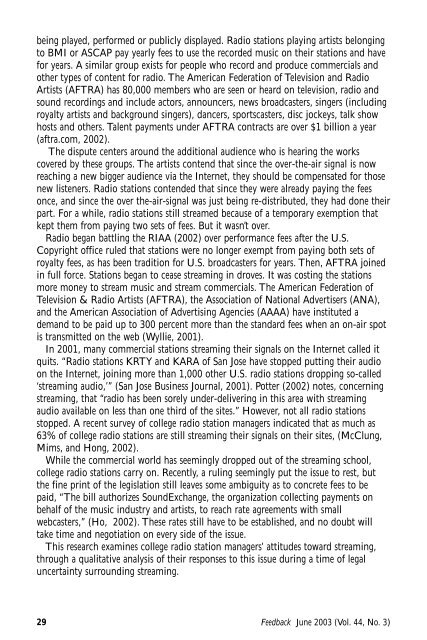JUNEFeedback
Issue 3 - Broadcast Education Association
Issue 3 - Broadcast Education Association
You also want an ePaper? Increase the reach of your titles
YUMPU automatically turns print PDFs into web optimized ePapers that Google loves.
eing played, performed or publicly displayed. Radio stations playing artists belongingto BMI or ASCAP pay yearly fees to use the recorded music on their stations and havefor years. A similar group exists for people who record and produce commercials andother types of content for radio. The American Federation of Television and RadioArtists (AFTRA) has 80,000 members who are seen or heard on television, radio andsound recordings and include actors, announcers, news broadcasters, singers (includingroyalty artists and background singers), dancers, sportscasters, disc jockeys, talk showhosts and others. Talent payments under AFTRA contracts are over $1 billion a year(aftra.com, 2002).The dispute centers around the additional audience who is hearing the workscovered by these groups. The artists contend that since the over-the-air signal is nowreaching a new bigger audience via the Internet, they should be compensated for thosenew listeners. Radio stations contended that since they were already paying the feesonce, and since the over the-air-signal was just being re-distributed, they had done theirpart. For a while, radio stations still streamed because of a temporary exemption thatkept them from paying two sets of fees. But it wasn’t over.Radio began battling the RIAA (2002) over performance fees after the U.S.Copyright office ruled that stations were no longer exempt from paying both sets ofroyalty fees, as has been tradition for U.S. broadcasters for years. Then, AFTRA joinedin full force. Stations began to cease streaming in droves. It was costing the stationsmore money to stream music and stream commercials. The American Federation ofTelevision & Radio Artists (AFTRA), the Association of National Advertisers (ANA),and the American Association of Advertising Agencies (AAAA) have instituted ademand to be paid up to 300 percent more than the standard fees when an on-air spotis transmitted on the web (Wyllie, 2001).In 2001, many commercial stations streaming their signals on the Internet called itquits. “Radio stations KRTY and KARA of San Jose have stopped putting their audioon the Internet, joining more than 1,000 other U.S. radio stations dropping so-called‘streaming audio,’” (San Jose Business Journal, 2001). Potter (2002) notes, concerningstreaming, that “radio has been sorely under-delivering in this area with streamingaudio available on less than one third of the sites.” However, not all radio stationsstopped. A recent survey of college radio station managers indicated that as much as63% of college radio stations are still streaming their signals on their sites, (McClung,Mims, and Hong, 2002).While the commercial world has seemingly dropped out of the streaming school,college radio stations carry on. Recently, a ruling seemingly put the issue to rest, butthe fine print of the legislation still leaves some ambiguity as to concrete fees to bepaid, “The bill authorizes SoundExchange, the organization collecting payments onbehalf of the music industry and artists, to reach rate agreements with smallwebcasters,” (Ho, 2002). These rates still have to be established, and no doubt willtake time and negotiation on every side of the issue.This research examines college radio station managers’ attitudes toward streaming,through a qualitative analysis of their responses to this issue during a time of legaluncertainty surrounding streaming.29Feedback June 2003 (Vol. 44, No. 3)
















